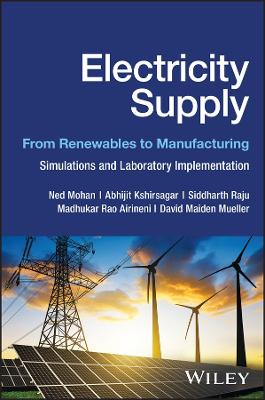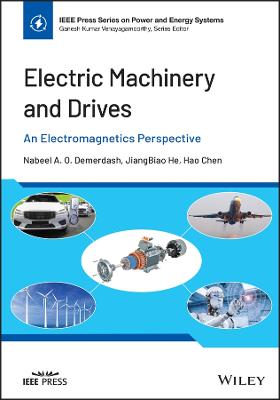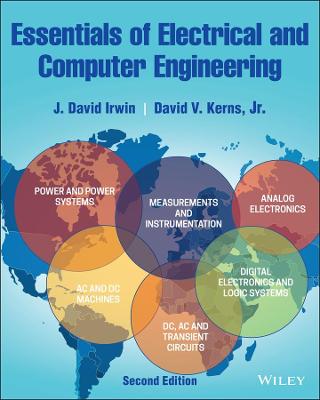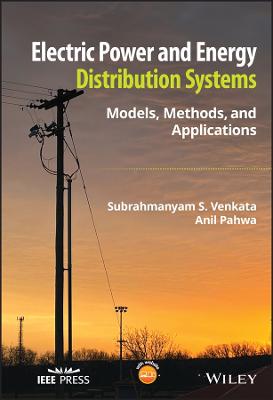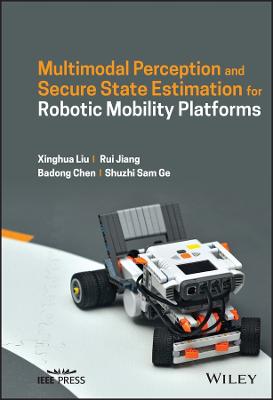Design of Three-phase AC Power Electronics Converters
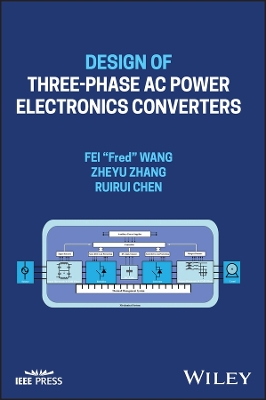 -15%
portes grátis
-15%
portes grátis
Design of Three-phase AC Power Electronics Converters
Wang, Fei "Fred"; Zhang, Zheyu; Chen, Ruirui
John Wiley & Sons Inc
11/2023
688
Dura
Inglês
9781119794233
15 a 20 dias
666
Descrição não disponível.
About the Authors xiii
Preface xv
Acknowledgments xvii
1 Introduction 1
1.1 Basics of Three-Phase AC Converters 1
1.2 Basics of Three-Phase AC Converter Design 20
1.3 Goal and Organization of This Book 26
Part I Components 31
2 Power Semiconductor Devices 33
2.1 Introduction 33
2.2 Static Characteristics 35
2.3 Switching Characteristics 50
2.4 Thermal Characteristics 57
2.5 Other Attributes 60
2.6 Scalability (Parallel/Series) 68
2.7 Relevance to Converter Design 70
2.8 Summary 72
3 Capacitors 75
3.1 Introduction 75
3.2 Capacitor Types and Technologies 75
3.3 Capacitor Selection in a Converter Design 82
3.4 Capacitor Characteristics and Models 84
3.5 Capacitor Bank (Parallel/Series) 98
3.6 Relevance to Converter Design 100
3.7 Summary 102
4 Magnetics 105
4.1 Introduction 105
4.2 Magnetic Core Materials and Construction 105
4.3 Inductor Design in a Converter 108
4.4 Inductor Characteristics and Models 110
4.5 Relevance to Converter Design 127
4.5.1 Capacitor Winding Capacitance 127
4.6 Summary 128
Part II Subsystems Design 131
5 Passive Rectifiers 133
5.1 Introduction 133
5.2 Passive Rectifier Design Problem Formulation 135
5.3 Passive Rectifier Models 140
5.4 Passive Rectifier Design Optimization 157
5.5 Interface to Other Subsystem Designs 161
5.6 Summary 164
6 Load-side Inverters 167
6.1 Introduction 167
6.2 Load-side Inverter Design Problem Formulation 167
6.3 Load-side Inverter Models 173
6.4 Load-side Inverter Design Optimization 230
6.5 Load-side Inverter Interfaces to Other Subsystem Designs 236
6.6 Summary 241
7 Active Rectifiers and Source-side Inverters 245
7.1 Introduction 245
7.2 Active Rectifier and Source-side Inverter Design Problem Formulation 245
7.3 Active Rectifier and Source-side Inverter Models 251
7.4 Active Rectifier and Source-side Inverter Design Optimization 280
7.5 Impact of Topology 280
7.6 Active Rectifier and Source-side Inverter Interfaces to Other Subsystem Designs 300
7.7 Summary 300
8 EMI Filters 305
8.1 Introduction 305
8.2 EMI Filter Design Basics 306
8.3 EMI Filter Design Problem Formulation 324
8.4 EMI Filter Models 326
8.5 EMI Filter Design Optimization and Some Practical Considerations 343
8.6 EMI Noise and Filter Reduction Techniques 353
8.7 Interface to Other Subsystem Designs 365
8.8 Summary 366
9 Thermal Management System 369
9.1 Introduction 369
9.2 Cooling Technology Overview 369
9.3 Thermal Management System Design Problem Formulation 384
9.4 Thermal Management System Models 388
9.5 Thermal Management System Design Optimization 393
9.6 Thermal Management System Interface to Other Subsystems 397
9.7 Other Cooling Considerations 400
9.8 Summary 407
10 Control and Auxiliaries 411
10.1 Introduction 411
10.2 Control Architecture 411
10.3 Control Hardware Selection and Design 414
10.4 Isolation 415
10.5 Gate Driver 418
10.6 Sensors and Measurements 430
10.7 Protection 445
10.8 Printed Circuit Boards 452
10.9 Deadtime Setting and Compensation 455
10.10 Interface to Other Subsystems 466
10.11 Summary 467
11 Mechanical System 471
11.1 Introduction 471
11.2 Mechanical System Design Problem Formulation 475
11.3 Busbar Design 482
11.4 Mechanical System Interface to Other Subsystems 502
11.5 Summary 504
12 Application Considerations 507
12.1 Introduction 507
12.2 Motor Drive Applications 507
12.3 Grid Applications 547
12.4 Summary 577
Part III Design Optimization 581
13 Design Optimization 583
13.1 Introduction 583
13.2 Design Optimization Concept and Procedure 583
13.3 Optimization Algorithms 587
13.4 Partitioned Optimizers vs. Single Optimizer for Converter Design 590
13.5 Design Tool Development 596
13.6 Virtual Prototyping 638
13.7 Summary 642
References 643
Index 647
Preface xv
Acknowledgments xvii
1 Introduction 1
1.1 Basics of Three-Phase AC Converters 1
1.2 Basics of Three-Phase AC Converter Design 20
1.3 Goal and Organization of This Book 26
Part I Components 31
2 Power Semiconductor Devices 33
2.1 Introduction 33
2.2 Static Characteristics 35
2.3 Switching Characteristics 50
2.4 Thermal Characteristics 57
2.5 Other Attributes 60
2.6 Scalability (Parallel/Series) 68
2.7 Relevance to Converter Design 70
2.8 Summary 72
3 Capacitors 75
3.1 Introduction 75
3.2 Capacitor Types and Technologies 75
3.3 Capacitor Selection in a Converter Design 82
3.4 Capacitor Characteristics and Models 84
3.5 Capacitor Bank (Parallel/Series) 98
3.6 Relevance to Converter Design 100
3.7 Summary 102
4 Magnetics 105
4.1 Introduction 105
4.2 Magnetic Core Materials and Construction 105
4.3 Inductor Design in a Converter 108
4.4 Inductor Characteristics and Models 110
4.5 Relevance to Converter Design 127
4.5.1 Capacitor Winding Capacitance 127
4.6 Summary 128
Part II Subsystems Design 131
5 Passive Rectifiers 133
5.1 Introduction 133
5.2 Passive Rectifier Design Problem Formulation 135
5.3 Passive Rectifier Models 140
5.4 Passive Rectifier Design Optimization 157
5.5 Interface to Other Subsystem Designs 161
5.6 Summary 164
6 Load-side Inverters 167
6.1 Introduction 167
6.2 Load-side Inverter Design Problem Formulation 167
6.3 Load-side Inverter Models 173
6.4 Load-side Inverter Design Optimization 230
6.5 Load-side Inverter Interfaces to Other Subsystem Designs 236
6.6 Summary 241
7 Active Rectifiers and Source-side Inverters 245
7.1 Introduction 245
7.2 Active Rectifier and Source-side Inverter Design Problem Formulation 245
7.3 Active Rectifier and Source-side Inverter Models 251
7.4 Active Rectifier and Source-side Inverter Design Optimization 280
7.5 Impact of Topology 280
7.6 Active Rectifier and Source-side Inverter Interfaces to Other Subsystem Designs 300
7.7 Summary 300
8 EMI Filters 305
8.1 Introduction 305
8.2 EMI Filter Design Basics 306
8.3 EMI Filter Design Problem Formulation 324
8.4 EMI Filter Models 326
8.5 EMI Filter Design Optimization and Some Practical Considerations 343
8.6 EMI Noise and Filter Reduction Techniques 353
8.7 Interface to Other Subsystem Designs 365
8.8 Summary 366
9 Thermal Management System 369
9.1 Introduction 369
9.2 Cooling Technology Overview 369
9.3 Thermal Management System Design Problem Formulation 384
9.4 Thermal Management System Models 388
9.5 Thermal Management System Design Optimization 393
9.6 Thermal Management System Interface to Other Subsystems 397
9.7 Other Cooling Considerations 400
9.8 Summary 407
10 Control and Auxiliaries 411
10.1 Introduction 411
10.2 Control Architecture 411
10.3 Control Hardware Selection and Design 414
10.4 Isolation 415
10.5 Gate Driver 418
10.6 Sensors and Measurements 430
10.7 Protection 445
10.8 Printed Circuit Boards 452
10.9 Deadtime Setting and Compensation 455
10.10 Interface to Other Subsystems 466
10.11 Summary 467
11 Mechanical System 471
11.1 Introduction 471
11.2 Mechanical System Design Problem Formulation 475
11.3 Busbar Design 482
11.4 Mechanical System Interface to Other Subsystems 502
11.5 Summary 504
12 Application Considerations 507
12.1 Introduction 507
12.2 Motor Drive Applications 507
12.3 Grid Applications 547
12.4 Summary 577
Part III Design Optimization 581
13 Design Optimization 583
13.1 Introduction 583
13.2 Design Optimization Concept and Procedure 583
13.3 Optimization Algorithms 587
13.4 Partitioned Optimizers vs. Single Optimizer for Converter Design 590
13.5 Design Tool Development 596
13.6 Virtual Prototyping 638
13.7 Summary 642
References 643
Index 647
Este título pertence ao(s) assunto(s) indicados(s). Para ver outros títulos clique no assunto desejado.
three-phase AC converter design; converter design; converter components; design of subsystems; passive rectifiers; inverters; active rectifiers; electromagnetic interference (EMI) filters; thermal management system; converter design optimization
About the Authors xiii
Preface xv
Acknowledgments xvii
1 Introduction 1
1.1 Basics of Three-Phase AC Converters 1
1.2 Basics of Three-Phase AC Converter Design 20
1.3 Goal and Organization of This Book 26
Part I Components 31
2 Power Semiconductor Devices 33
2.1 Introduction 33
2.2 Static Characteristics 35
2.3 Switching Characteristics 50
2.4 Thermal Characteristics 57
2.5 Other Attributes 60
2.6 Scalability (Parallel/Series) 68
2.7 Relevance to Converter Design 70
2.8 Summary 72
3 Capacitors 75
3.1 Introduction 75
3.2 Capacitor Types and Technologies 75
3.3 Capacitor Selection in a Converter Design 82
3.4 Capacitor Characteristics and Models 84
3.5 Capacitor Bank (Parallel/Series) 98
3.6 Relevance to Converter Design 100
3.7 Summary 102
4 Magnetics 105
4.1 Introduction 105
4.2 Magnetic Core Materials and Construction 105
4.3 Inductor Design in a Converter 108
4.4 Inductor Characteristics and Models 110
4.5 Relevance to Converter Design 127
4.5.1 Capacitor Winding Capacitance 127
4.6 Summary 128
Part II Subsystems Design 131
5 Passive Rectifiers 133
5.1 Introduction 133
5.2 Passive Rectifier Design Problem Formulation 135
5.3 Passive Rectifier Models 140
5.4 Passive Rectifier Design Optimization 157
5.5 Interface to Other Subsystem Designs 161
5.6 Summary 164
6 Load-side Inverters 167
6.1 Introduction 167
6.2 Load-side Inverter Design Problem Formulation 167
6.3 Load-side Inverter Models 173
6.4 Load-side Inverter Design Optimization 230
6.5 Load-side Inverter Interfaces to Other Subsystem Designs 236
6.6 Summary 241
7 Active Rectifiers and Source-side Inverters 245
7.1 Introduction 245
7.2 Active Rectifier and Source-side Inverter Design Problem Formulation 245
7.3 Active Rectifier and Source-side Inverter Models 251
7.4 Active Rectifier and Source-side Inverter Design Optimization 280
7.5 Impact of Topology 280
7.6 Active Rectifier and Source-side Inverter Interfaces to Other Subsystem Designs 300
7.7 Summary 300
8 EMI Filters 305
8.1 Introduction 305
8.2 EMI Filter Design Basics 306
8.3 EMI Filter Design Problem Formulation 324
8.4 EMI Filter Models 326
8.5 EMI Filter Design Optimization and Some Practical Considerations 343
8.6 EMI Noise and Filter Reduction Techniques 353
8.7 Interface to Other Subsystem Designs 365
8.8 Summary 366
9 Thermal Management System 369
9.1 Introduction 369
9.2 Cooling Technology Overview 369
9.3 Thermal Management System Design Problem Formulation 384
9.4 Thermal Management System Models 388
9.5 Thermal Management System Design Optimization 393
9.6 Thermal Management System Interface to Other Subsystems 397
9.7 Other Cooling Considerations 400
9.8 Summary 407
10 Control and Auxiliaries 411
10.1 Introduction 411
10.2 Control Architecture 411
10.3 Control Hardware Selection and Design 414
10.4 Isolation 415
10.5 Gate Driver 418
10.6 Sensors and Measurements 430
10.7 Protection 445
10.8 Printed Circuit Boards 452
10.9 Deadtime Setting and Compensation 455
10.10 Interface to Other Subsystems 466
10.11 Summary 467
11 Mechanical System 471
11.1 Introduction 471
11.2 Mechanical System Design Problem Formulation 475
11.3 Busbar Design 482
11.4 Mechanical System Interface to Other Subsystems 502
11.5 Summary 504
12 Application Considerations 507
12.1 Introduction 507
12.2 Motor Drive Applications 507
12.3 Grid Applications 547
12.4 Summary 577
Part III Design Optimization 581
13 Design Optimization 583
13.1 Introduction 583
13.2 Design Optimization Concept and Procedure 583
13.3 Optimization Algorithms 587
13.4 Partitioned Optimizers vs. Single Optimizer for Converter Design 590
13.5 Design Tool Development 596
13.6 Virtual Prototyping 638
13.7 Summary 642
References 643
Index 647
Preface xv
Acknowledgments xvii
1 Introduction 1
1.1 Basics of Three-Phase AC Converters 1
1.2 Basics of Three-Phase AC Converter Design 20
1.3 Goal and Organization of This Book 26
Part I Components 31
2 Power Semiconductor Devices 33
2.1 Introduction 33
2.2 Static Characteristics 35
2.3 Switching Characteristics 50
2.4 Thermal Characteristics 57
2.5 Other Attributes 60
2.6 Scalability (Parallel/Series) 68
2.7 Relevance to Converter Design 70
2.8 Summary 72
3 Capacitors 75
3.1 Introduction 75
3.2 Capacitor Types and Technologies 75
3.3 Capacitor Selection in a Converter Design 82
3.4 Capacitor Characteristics and Models 84
3.5 Capacitor Bank (Parallel/Series) 98
3.6 Relevance to Converter Design 100
3.7 Summary 102
4 Magnetics 105
4.1 Introduction 105
4.2 Magnetic Core Materials and Construction 105
4.3 Inductor Design in a Converter 108
4.4 Inductor Characteristics and Models 110
4.5 Relevance to Converter Design 127
4.5.1 Capacitor Winding Capacitance 127
4.6 Summary 128
Part II Subsystems Design 131
5 Passive Rectifiers 133
5.1 Introduction 133
5.2 Passive Rectifier Design Problem Formulation 135
5.3 Passive Rectifier Models 140
5.4 Passive Rectifier Design Optimization 157
5.5 Interface to Other Subsystem Designs 161
5.6 Summary 164
6 Load-side Inverters 167
6.1 Introduction 167
6.2 Load-side Inverter Design Problem Formulation 167
6.3 Load-side Inverter Models 173
6.4 Load-side Inverter Design Optimization 230
6.5 Load-side Inverter Interfaces to Other Subsystem Designs 236
6.6 Summary 241
7 Active Rectifiers and Source-side Inverters 245
7.1 Introduction 245
7.2 Active Rectifier and Source-side Inverter Design Problem Formulation 245
7.3 Active Rectifier and Source-side Inverter Models 251
7.4 Active Rectifier and Source-side Inverter Design Optimization 280
7.5 Impact of Topology 280
7.6 Active Rectifier and Source-side Inverter Interfaces to Other Subsystem Designs 300
7.7 Summary 300
8 EMI Filters 305
8.1 Introduction 305
8.2 EMI Filter Design Basics 306
8.3 EMI Filter Design Problem Formulation 324
8.4 EMI Filter Models 326
8.5 EMI Filter Design Optimization and Some Practical Considerations 343
8.6 EMI Noise and Filter Reduction Techniques 353
8.7 Interface to Other Subsystem Designs 365
8.8 Summary 366
9 Thermal Management System 369
9.1 Introduction 369
9.2 Cooling Technology Overview 369
9.3 Thermal Management System Design Problem Formulation 384
9.4 Thermal Management System Models 388
9.5 Thermal Management System Design Optimization 393
9.6 Thermal Management System Interface to Other Subsystems 397
9.7 Other Cooling Considerations 400
9.8 Summary 407
10 Control and Auxiliaries 411
10.1 Introduction 411
10.2 Control Architecture 411
10.3 Control Hardware Selection and Design 414
10.4 Isolation 415
10.5 Gate Driver 418
10.6 Sensors and Measurements 430
10.7 Protection 445
10.8 Printed Circuit Boards 452
10.9 Deadtime Setting and Compensation 455
10.10 Interface to Other Subsystems 466
10.11 Summary 467
11 Mechanical System 471
11.1 Introduction 471
11.2 Mechanical System Design Problem Formulation 475
11.3 Busbar Design 482
11.4 Mechanical System Interface to Other Subsystems 502
11.5 Summary 504
12 Application Considerations 507
12.1 Introduction 507
12.2 Motor Drive Applications 507
12.3 Grid Applications 547
12.4 Summary 577
Part III Design Optimization 581
13 Design Optimization 583
13.1 Introduction 583
13.2 Design Optimization Concept and Procedure 583
13.3 Optimization Algorithms 587
13.4 Partitioned Optimizers vs. Single Optimizer for Converter Design 590
13.5 Design Tool Development 596
13.6 Virtual Prototyping 638
13.7 Summary 642
References 643
Index 647
Este título pertence ao(s) assunto(s) indicados(s). Para ver outros títulos clique no assunto desejado.

